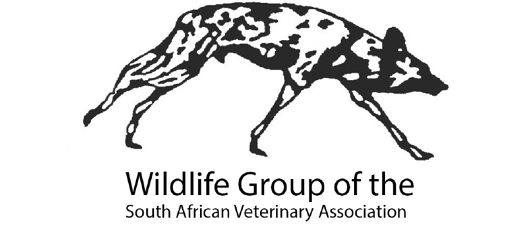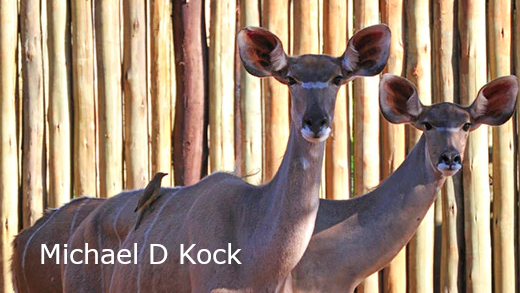Rabies is a fatal viral disease, which attacks the central nervous system (brain and spinal cord) of all mammals, including man.
This disease is endemic (occurs commonly and is widespread) in Namibia, with a high prevalence in the central and northern regions. In recent years the disease has also occurred in the southern and eastern parts of the country. Amongst wild herbivores, kudus appear to be the most susceptible to rabies, followed likely by eland. Within a kudu population, rabies most probably starts with a kudu being bitten by a rabid animal. However, further spread of this disease is associated with the species social behaviour, where communal grooming as well as group feeding from the same bush or tree are very common.
Over the past few years we have been vaccinating kudus and eland against rabies repeatedly on a number of game farms both during and following an outbreak. In all cases the farmers reported that the outbreak stopped within 10-14 days of vaccination. Those farms where kudu were prophylactically vaccinated annually or biannually, now support a thriving kudu population. Seeing the kudu prices of +/- 8000N$ for kudu cows, and 18.000N$ for a 47’’ kudu bull on the last game auction, it is well worth ones money to protect them against rabies.
The best time to vaccinate is before the bushes and trees start flowering. The animals are darted with drop-out darts from the helicopter, which is the quickest, cheapest and most effective way of vaccinating most animals on farms. When multiple neighbouring farms participate in such a vaccination campaign, it not only better protects the total kudu/eland population, but it also saves on kilometre and helicopter ferry costs.
The Pandemic and Rabies
The COVID-19 pandemic has had a profound effect on us all. Not a day goes by without people discussing concepts like infection rates, immunity, vaccination, herd immunity, social distancing etc. Winter (after the leaves have dropped from trees) is the optimal time of the year to vaccinate kudus and eland against rabies. It is therefore now a good time to discuss some of the above concepts and explain the similarities and vast differences between rabies transmission and prevention in our wildlife population compared to COVID-19 management in people.
Herd Immunity
When there is a major disease outbreak (epi- or pandemic), the end result is usually as follows:
-
Cases are tracked and isolated (in animal populations options such as quarantine and treatment, and culling may be applied), or
-
A population achieves herd immunity, often with the help of a vaccine (this may be in an isolation/quarantine environment, or out on the field).
In herd (population) immunity, members of a population benefit from indirect protection from an infectious disease (usually a virus) after a large percentage of that population has become immune to that disease.
Immunity can be achieved either by vaccinating people/animals against that disease (e.g. rabies or COVID-19) or, after a patient has been exposed to, and recovered from an infection and is now immune against that disease. The greater the percentage of immune individuals in a population, the more effective the physical shield they “build” around non-immune individuals will be, thus achieving the state of herd immunity. This will slow and eventually stop the spread of infection.
The level of population immunity needed to achieve herd immunity largely depends on the virus involved (infectivity, mortality rate etc.), the population (population density, susceptibility etc.) and on the nature of immunity achieved, but a figure between 60-90% is generally adopted.
Individuals can become immune by recovering from an infection or through vaccination. However, not all individuals within a population will pick up immunity (e.g. sick and/or too young to be vaccinated, and in wildlife, some animals will not be seen/spotted and thus “skip” being vaccinated). Herd immunity is essential to protect this group of individuals. Once a certain threshold (minimum 60- 70% of the population immune) has been reached, a disease will gradually be eliminated from a population. The figure on the next page shows the concept of herd immunity.




Top Picture: shows a disease outbreak in a population. Just a few animals are infected (red), and the rest are healthy but not immunized (normal colours). The disease will then spread freely through the entire population
Middel Picure: When a few animals are vaccinated (immunized, shown in green), a disease can still spread quickly to unvaccinated animals.
Bottom Picture: When most animals in the population are vaccinated, they limit the effectiveness of a disease. In other words, the disease is prevented from spreading throughout the entire population. The ability of immunized animals (or people) to protect others is what we call ‘herd immunity’.
In the first 2 examples, most kudus get rabies from the 2 infected kudus. In third example, only 1 additional kudu suffers from rabies. Most of the others are immune, and others are protected as they don't come into close contact with the infected animals.
© Based on an illustration of the National Institute of Allergy and Infectious Diseases (NIAID), edited by U. Tubbesing.
Rabies Compared to COVID-19

Compared to COVID-19, with rabies there is the huge benefit of a safe and highly efficient vaccine that provides man and animal with a relatively long lasting immunity. Since the average antelope herd grows by 25-30% annually, it is advisable to vaccinate a farm’s kudu and/or rabies population at least every 2 years.
Another important thing to remimber when comparing COVID-19 with Rabies, is mortality rate of rabies 100% of cases. Herd immunity can therefore not be achieved by animals recovering from infection. Vaccination therefore to achieve immunity is in fact the only way to curb the spread of the disease.
A disease outbreak can be totally prevented by prophylactic (preventative) vaccination (if a vaccine is available). In the absence of an effective vaccine the disease will spread unchecked until herd immunity is reached (this is applicable to COVID-19 but not rabies) and/or the population has been decimated to such an extent that a “social distancing” effect comes into play (see figure on the right). Delaying vaccination until an actual disease outbreak occurs will only be partially effective since a certain percentage of the population would have already died and more animals would be sick, still spreading the disease in the 7-21 days it takes before an animal develops proper immunity following vaccination.
Social Distancing

Considering the importance of kudus and eland as a game ranch species in Namibia, we believe that herd vaccination against rabies is the only realistic way in which herd immunity against this potentially devastating disease can be reached.
Thank you to Dr Ulf Tubessing for the art work and article!
Our Sponsors


1 comment
I think this is a great start guys!!